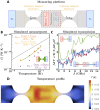The phonon quantum of thermal conductance: Are simulations and measurements estimating the same quantity?
- PMID: 37831773
- PMCID: PMC11090371
- DOI: 10.1126/sciadv.adi7439
The phonon quantum of thermal conductance: Are simulations and measurements estimating the same quantity?
Abstract
The thermal conductance quantum is a fundamental quantity in quantum transport theory. However, two decades after its first reported measurements and calculations for phonons in suspended nanostructures, reconciling experiments and theory remains elusive. Our massively parallel calculations of phonon transport in micrometer-sized three-dimensional structures suggest that part of the disagreement between theory and experiment stems from the inadequacy of macroscopic concepts to analyze the data. The computed local temperature distribution in the wave ballistic nonequilibrium regime shows that the spatial placement and dimensions of thermometers, heaters, and supporting microbeams in the suspended structures can noticeably affect the thermal conductance's measured values. In addition, diffusive transport assumptions made in the data analysis may result in measured values that considerably differ from the actual thermal conductance of the structure. These results urge for experimental validation of the suitability of diffusive transport assumptions in measuring devices operating at sub-kelvin temperatures.
Figures







References
-
- J. B. Pendry, Quantum limits to the flow of information and entropy. J. Phys. A. Math. Gen. 16, 2161–2171 (1983).
-
- J. P. Pekola, B. Karimi, Colloquium: Quantum heat transport in condensed matter systems. Rev. Mod. Phys. 93, 041001 (2021).
-
- S. Jezouin, F. D. Parmentier, A. Anthore, U. Gennser, A. Cavanna, Y. Jin, F. Pierre, Quantum limit of heat flow across a single electronic channel. Science 342, 601–604 (2013). - PubMed
-
- N. Mosso, U. Drechsler, F. Menges, P. Nirmalraj, S. Karg, H. Riel, B. Gotsmann, Heat transport through atomic contacts. Nat. Nanotechnol. 12, 430–433 (2017). - PubMed
-
- L. Cui, W. Jeong, S. Hur, M. Matt, J. C. Klöckner, F. Pauly, P. Nielaba, J. C. Cuevas, E. Meyhofer, P. Reddy, Quantized thermal transport in single-atom junctions. Science 355, 1192–1195 (2017). - PubMed
LinkOut - more resources
Full Text Sources

